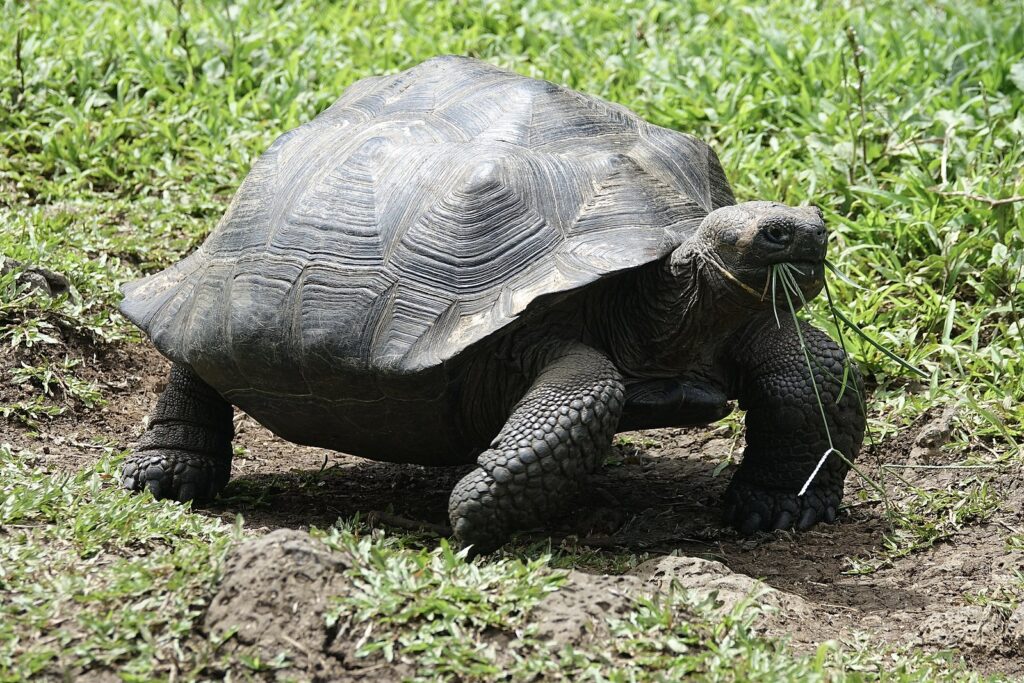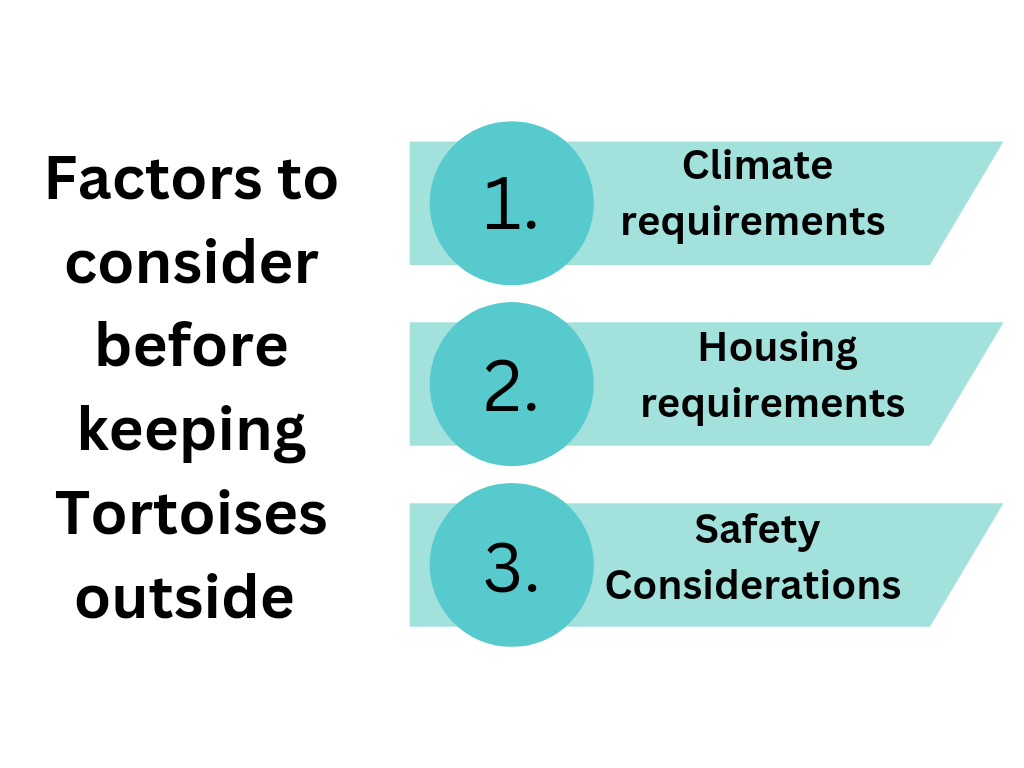
Image: Galapagos tortoise Wikimedia CommonsCC 2.0
Can a tortoise live outside? It’s a common question for pet owners and animal fans. It’s key to understand these creatures’ natural habitats and needs before making a decision.
First, consider the species of tortoise you have or plan to get. Each species has different environmental demands, so research their habitats thoroughly. For instance, Russian tortoises thrive in dry climates with lots of sunlight, while red-footed tortoises favor more humid environments.
Also think about your geographic location. If you live in a place with extreme weather like cold winters or hot summers, it might not be suitable to keep a tortoise outside. Tortoises rely on external heat sources to regulate their body temperature. Without proper protection and warmth, they might struggle to survive.
Giving proper shelter to an outdoor tortoise is vital for its well-being. This includes making a secure enclosure to prevent escape and provide shade from direct sunlight on hot days. The enclosure should also have vegetation and hiding spots for protection from predators and bad weather.
Eric’s story is a great example of why housing matters. He was a sulcata tortoise found wandering without shelter in a neighborhood. Thankfully, an animal rescue organization saved him and he now lives happily with his new owners who give him a spacious enclosure and care.
Tortoises don’t need fancy apartments! They can just chill in their natural habitats-like an eternal vacation with free rent!
Key Takeaways
- Tortoises can live outside, but it is important to provide them with the proper environment and care.
- Outdoor enclosures for tortoises should be spacious, secure, and have a variety of natural elements such as rocks, plants, and hiding spots.
- Tortoises need access to sunlight for vitamin D synthesis, so it is important to provide them with a sunny area in their enclosure.
- It is crucial to monitor the temperature and humidity levels in the outdoor enclosure to ensure the tortoise’s well-being.
- Tortoises should have a balanced diet consisting of a variety of vegetables, fruits, and occasional protein sources.
- Regular veterinary check-ups are necessary to ensure the tortoise’s health and to address any potential issues.
- It is important to research and understand the specific needs of the tortoise species you have before deciding to keep them outside.
Understanding the natural habitat of tortoises
Tortoises rely on external sources of heat to regulate their body temperature. So, they bask in the sun and seek shade when it gets too hot. Their shells protect them from predators and provide insulation during colder weather. Plus, tortoises are pros at conserving water.
Different species of tortoises have different requirements for temperature and humidity. Some prefer arid regions, whereas others thrive in humid environments. So, if you’re keeping a tortoise outside, make sure to replicate these conditions as closely as possible.
Not all tortoises are suited for outdoor living. Some do better indoors due to climate restrictions or potential dangers. And, human activities like urbanization and land degradation are decreasing the amount of suitable habitats for wild tortoises, causing their populations to decline and their risk of extinction to increase.
For example, take George – a Sulcata tortoise. He was born and raised in captivity, but was lucky enough to experience living outside during summer months. His owner monitored environmental conditions like temperature and humidity to keep George safe and comfy.
To sum it up, understanding the natural habitat of tortoises is essential. Make sure you provide the right conditions and consider any risks or limitations. That way, we can make sure these fascinating creatures have a long, happy life in our care.
Factors to consider before keeping a tortoise outside

To ensure the well-being of your tortoise in an outdoor setting, it is crucial to take various factors into account. Consider the climate requirements, housing requirements, and safety considerations. By addressing these sub-sections, you can provide an optimal environment for your tortoise to thrive outside.
Climate requirements
Climate is vital for a tortoise’s wellbeing. Temperature, humidity and sunlight need to be taken into account before keeping them outdoors. Check out this table for the climate requirements:
| Climate Requirements | Temperature | Humidity | Sunlight |
|---|---|---|---|
| Day | 75-90°F(24-32°C) | 50-70% | 12-14 hours |
| Night | 65-75°F (18-24°C) | Slightly lower | None |
Certain species have specific climate needs. For instance, Mediterranean tortoises prefer warm and dry climates, while tropical tortoises need higher humidity.
Giving the correct climate conditions is key for a tortoise’s health. Temperature, humidity and sunlight should imitate their natural habitat. Neglecting these requirements can have severe consequences for your tortoise. Make sure to provide for your shelled companion – they deserve a comfy home!
Housing requirements
Providing the right housing for a tortoise is key for its wellness. Skipping this can cause various health issues.
When it comes to tortoise’s housing, there are three essential points to consider:
- Enclosure size: The enclosure should be roomy enough to let the tortoise roam easily. Give it plenty of room for both walking & basking. A guideline is the enclosure should be four times the length of the tortoise’s shell.
- Temperature control: Tortoises need a precise temperature range to flourish. Provide a warm basking area with direct access to UVB lighting for metabolizing calcium and stay healthy. Also, offer a cooler spot within the enclosure for regulating the tortoise’s body temperature.
- Substrate choice: Selecting an appropriate substrate is vital for the tortoise’s health and hygiene. Avoid substrates that easily keep moisture or become moldy, as these can lead to respiratory issues. Opt for materials like cypress mulch or coconut coir, which give good drainage.
In addition to these primary requirements, think about offering hiding places in the enclosure for the tortoise to retreat when feeling stressed or threatened. These shelters help give a sense of security to your pet.
Pro Tip: Frequently inspect and clean the tortoise’s enclosure for hygiene and to avert the buildup of bacteria or parasites.
Remember, a tortoise is no match for a neighborhood dog looking for a game of ‘catch and carry’.
Safety considerations
A tortoise enclosure is like creating a magnificent prison for a slow-moving fugitive. It’s important to take safety measures to guard against extreme weather, predator attacks, and escaping. Fencing or walls are essential to keep the tortoise in. Plus, watch out for plants that may be toxic if ingested. Gates and entrances should also be secured to avoid accidental escapes. With these precautions, you’ll provide a secure outdoor habitat for your tortoise.
Historical experiences remind us that inadequate shelter and insufficient predator protection can lead to unsafe conditions. So, let’s learn from the past and provide better care for our beloved tortoises.
Steps to prepare an outdoor enclosure for a tortoise
To prepare an outdoor enclosure for a tortoise with the sub-sections “Choosing the right location, Constructing a secure enclosure, Providing appropriate substrates and shelters” as solutions briefly.
Choosing the right location
Location Factors
| Details | |
|---|---|
| Sun Exposure | Give proper sunlight to make Vitamin D. |
| Protection | Keep safe from bad weather and predators. |
| Drainage | Make sure water doesn’t stay too long. |
| Size | Give enough room for movement and exploring. |
| Vegetation | Put some grass and plants in for hiding and foraging. |
Also, keep the enclosure away from loud noises and busy places. Now that you know how to pick the best spot, make your pet’s home a happy and healthy one.
Pro Tip: Before deciding, get advice from an expert about your tortoise’s species. Making a tortoise home is like setting up a secure prison, but with more lettuce and fewer escapees.
Constructing a secure enclosure
Constructing a secure enclosure for your tortoise is key. Walls should be made from sturdy materials, such as wood or wire mesh, to prevent predators from entering. Ensure that it’s spacious enough for your pet to move around comfortably and include hiding spots and areas for basking in the sun. Create a secure lid or cover to protect your tortoise. Be mindful of any potential hazards, like sharp edges or toxic plants close to the enclosure.
Provide a shallow dish of clean water for your tortoise to drink from and soak in.
Ancient Egyptians kept tortoises as sacred animals and built enclosures specifically designed for their care. Today, we understand how to construct a secure enclosure in order to provide our pets with a safe and comfortable environment.
Give your tortoise a range of substrates and shelters, they deserve the same level of care as a Kardashian!
Providing appropriate substrates and shelters
Selecting the right substrate is important for tortoises. Choose materials like topsoil or sand. These allow them to dig and burrow without harm. Avoid sharp and coarse substances that can injure them.
Also, incorporate various shelters. Logs, rocks, and purpose-built hideaways give tortoises places to feel safe. Make sure there are enough shelters for each tortoise if you have multiples.
Provide basking areas with shade and direct sunlight. This helps them regulate their body temperature. A combination of shaded and sunny spots is ideal.
Remember that different species of tortoises may have different requirements. Research thoroughly to meet their specific needs.
Providing substrates and shelters promotes physical and mental stimulation. By replicating their natural environment, you create a space for them to thrive.
The Tortoise Trust published an article emphasizing the importance of offering multiple hiding spots. This helps reduce stress in captive tortoises.
Finally, keep in mind that tortoises’ poop seems to escape faster than Usain Bolt! Ensure that your outdoor enclosure is properly maintained.
Maintaining the outdoor enclosure
To maintain the outdoor enclosure for your tortoise, ensure temperature and humidity control. Provide proper nutrition and hydration, and schedule regular health check-ups and care. These elements play a crucial role in creating a suitable and comfortable environment for your tortoise in an outdoor setting.
Temperature and humidity control
Temperature and humidity management in outdoor enclosures is essential for a healthy atmosphere. Let us explore the importance of temperature and humidity control and the methods to do so.
Heating is a must, using heaters. Cooling is essential, employing fans. To regulate moisture, sprinklers are necessary.
Maintaining temperature and humidity levels is critical for the animals living in outdoor enclosures. Heaters provide warmth to imitate their natural habitat during colder times. Fans help to reduce heatwaves. Sprinklers help with moisture regulation to keep the creatures comfortable.
Ancient civilizations also considered temperature and humidity control in their enclosures. Mesopotamians had underground irrigation systems to maintain cooler temperatures and higher humidity levels for gardens and animal habitats. This shows our commitment to creating a perfect environment for them.
By understanding how important temperature and humidity control is, we can cater to the needs of animals in the enclosure. Effective heating, cooling, and moisture regulation guarantee their wellbeing; just as ancient civilizations used innovative techniques to achieve harmony with nature.
But remember, a balanced diet is essential for your outdoor animals, unless you want them to plan their escape and start their own fast food place.
Providing proper nutrition and hydration
For healthy outdoor enclosures, providing the right nutrition and hydration is essential. This gives the inhabitants the energy they need to thrive. To ensure proper nutrition:
- Supply a balanced diet of fresh fruits, veggies, and protein sources like bugs or seeds.
- Provide clean water regularly.
- Research the dietary preferences of the animals and cater to their needs.
- Don’t overfeed – monitor and adjust portions accordingly.
- Consult a vet or expert if unsure.
Additionally, factor in seasonal changes, age, and activity levels when deciding their nutritional requirements. Promote proper nutrition and hydration by offering diverse food options and water sources throughout the enclosure. Also, incorporate supplements or fortified foods if needed. Finally, adjust feeding schedules as per individual needs.
Remember, proper nutrition and hydration is more than just food and water – it’s understanding each animal’s needs and supplying them with the necessary nourishment for wellbeing.
Regular health check-ups and care
It’s essential to have regular health check-ups for your pets. Inspect their fur/feathers for parasites like fleas or mites. Also, assess their body weight and condition. Monitor their mental well-being too – provide them with mental stimulation and social interaction. Sanitize their environment and remove waste promptly to prevent diseases.
Allow your pets time outside in a safe enclosure. Natural sunlight and fresh air stimulate their senses. Supervise them to avoid accidents.
Rachel had an outdoor aviary with birds. She noticed a bump on one of them. She contacted an avian vet and the tumor was removed. Thanks to her regular monitoring, the bird made a full recovery. Remember to lock up your enclosure – unless your critters learn how to pick locks!
Frequently Asked Questions
1. Can a tortoise live outside?
Yes, tortoises can live outside. In fact, many species of tortoises thrive in outdoor environments. However, appropriate living conditions must be provided to ensure their health and well-being.
2. What are the ideal living conditions for a tortoise outside?
Tortoises require an outdoor enclosure that replicates their natural habitat. This includes a spacious area with ample hiding spots, access to sunlight for basking, and a variety of vegetation to graze on. The enclosure should be secure to protect them from predators.
3. Can a tortoise withstand different weather conditions?
Tortoises are well-adapted to various weather conditions, but extreme temperatures can be harmful. It is important to provide shelter or a heated area during cold winters or excessively hot summers. Monitoring weather conditions and making necessary adjustments to their enclosure is crucial for their well-being.
4. Do tortoises need any special diet when living outside?
Tortoises require a balanced diet consisting of leafy greens, vegetables, fruits, and occasional protein sources like insects. In an outdoor setting, they have the opportunity to graze on natural vegetation, but their diet should also be supplemented with commercial tortoise pellets to ensure proper nutrition.
5. How often should a tortoise be checked when living outside?
Tortoises living outside should be checked daily to ensure they are healthy and have access to food, water, and a comfortable environment. Regular checks also allow you to monitor their behavior and address any concerns promptly.
6. Can a tortoise be kept as a pet outside all year round?
While tortoises can be kept outside throughout the year, careful consideration must be given to the climate and weather conditions of your specific location. In extreme climates, it may be necessary to provide additional protection or bring them indoors during harsh seasons.
Conclusion
A tortoise can be outdoors as long as it has a well-suited environment. This should include a roomy enclosure with a proper temperature, lots of hiding spots, and a wide selection of food. Plus, daily access to sunlight and fresh water is essential for the tortoise’s health.
Temperature needs to be monitored inside the enclosure. Tortoises are creatures that need external heat to control their body temperature. To do this, they need a spot to bask with a heat lamp nearby.
Creating a habitat that looks like the natural environment of the tortoise species is important. This could involve adding rocks, greenery, and even pools or burrows they can explore and hide in. These things not only give them something to do, but also keep them mentally stimulated.
For food, leafy greens should be the main component. Fruits and vegetables are okay to eat on occasion. Toxic plants and high protein foods should be avoided as they can lead to health issues.
.Remember – consulting a vet who specializes in reptiles can help you take good care of your tortoise. Their advice can help keep your pet happy and healthy in its natural environment.
References




